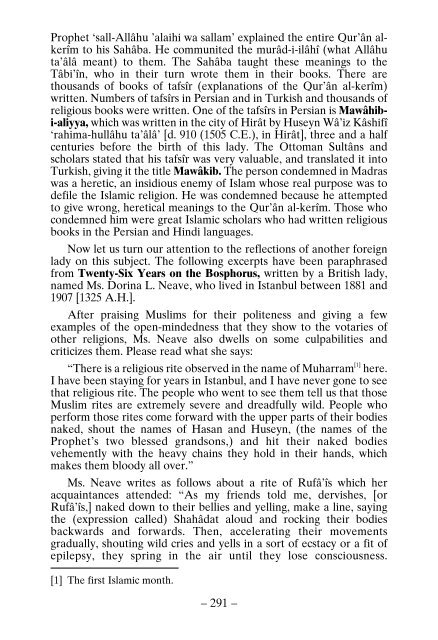Why Did They Become Muslims
WHY DID THEY BECOME MUSLIMS? The book Why Did They Become Muslims consists of 3 sections. Section I is a book of Islam and Christianity. Information about Prophets, books, religions (Judaism, Christianity and Islam) is given, conditions of being a true Muslim are explained, the words of those filled with admiration for Islam and the lives of 42 people who being a member of other religions chose Islam are narrated. Section II is a book of the Qur’an-ı Karîm and the Torah and the Bibles as of Today. Information about today’s Torah and Bibles is given, errors in the Bible are explained; that the Qur’an-ı Karîm is the last and unchangeable book is explained scientifically. Besides, explained are miracles, virtues, moral practices and habits of Muhammad ´alayhissalâm. Section III is a book of Islam and Other Religions. That Islam is not a religion of savageness, that a true Muslim is not ignorant, that there can be no philosophy in Islam are explained along with explanations of primitive religions and celestial religions.
WHY DID THEY BECOME MUSLIMS?
The book Why Did They Become Muslims consists of 3 sections. Section I is a book of Islam and Christianity. Information about Prophets, books, religions (Judaism, Christianity and Islam) is given, conditions of being a true Muslim are explained, the words of those filled with admiration for Islam and the lives of 42 people who being a member of other religions chose Islam are narrated. Section II is a book of the Qur’an-ı Karîm and the Torah and the Bibles as of Today. Information about today’s Torah and Bibles is given, errors in the Bible are explained; that the Qur’an-ı Karîm is the last and unchangeable book is explained scientifically. Besides, explained are miracles, virtues, moral practices and habits of Muhammad ´alayhissalâm. Section III is a book of Islam and Other Religions. That Islam is not a religion of savageness, that a true Muslim is not ignorant, that there can be no philosophy in Islam are explained along with explanations of primitive religions and celestial religions.
You also want an ePaper? Increase the reach of your titles
YUMPU automatically turns print PDFs into web optimized ePapers that Google loves.
Prophet ‘sall-Allâhu ’alaihi wa sallam’ explained the entire Qur’ân alkerîm<br />
to his Sahâba. He communited the murâd-i-ilâhî (what Allâhu<br />
ta’âlâ meant) to them. The Sahâba taught these meanings to the<br />
Tâbi’în, who in their turn wrote them in their books. There are<br />
thousands of books of tafsîr (explanations of the Qur’ân al-kerîm)<br />
written. Numbers of tafsîrs in Persian and in Turkish and thousands of<br />
religious books were written. One of the tafsîrs in Persian is Mawâhibi-aliyya,<br />
which was written in the city of Hirât by Huseyn Wâ’iz Kâshifî<br />
‘rahima-hullâhu ta’âlâ’ [d. 910 (1505 C.E.), in Hirât], three and a half<br />
centuries before the birth of this lady. The Ottoman Sultâns and<br />
scholars stated that his tafsîr was very valuable, and translated it into<br />
Turkish, giving it the title Mawâkib. The person condemned in Madras<br />
was a heretic, an insidious enemy of Islam whose real purpose was to<br />
defile the Islamic religion. He was condemned because he attempted<br />
to give wrong, heretical meanings to the Qur’ân al-kerîm. Those who<br />
condemned him were great Islamic scholars who had written religious<br />
books in the Persian and Hindi languages.<br />
Now let us turn our attention to the reflections of another foreign<br />
lady on this subject. The following excerpts have been paraphrased<br />
from Twenty-Six Years on the Bosphorus, written by a British lady,<br />
named Ms. Dorina L. Neave, who lived in Istanbul between 1881 and<br />
1907 [1325 A.H.].<br />
After praising <strong>Muslims</strong> for their politeness and giving a few<br />
examples of the open-mindedness that they show to the votaries of<br />
other religions, Ms. Neave also dwells on some culpabilities and<br />
criticizes them. Please read what she says:<br />
“There is a religious rite observed in the name of Muharram [1] here.<br />
I have been staying for years in Istanbul, and I have never gone to see<br />
that religious rite. The people who went to see them tell us that those<br />
Muslim rites are extremely severe and dreadfully wild. People who<br />
perform those rites come forward with the upper parts of their bodies<br />
naked, shout the names of Hasan and Huseyn, (the names of the<br />
Prophet’s two blessed grandsons,) and hit their naked bodies<br />
vehemently with the heavy chains they hold in their hands, which<br />
makes them bloody all over.”<br />
Ms. Neave writes as follows about a rite of Rufâ’îs which her<br />
acquaintances attended: “As my friends told me, dervishes, [or<br />
Rufâ’îs,] naked down to their bellies and yelling, make a line, saying<br />
the (expression called) Shahâdat aloud and rocking their bodies<br />
backwards and forwards. Then, accelerating their movements<br />
gradually, shouting wild cries and yells in a sort of ecstacy or a fit of<br />
epilepsy, they spring in the air until they lose consciousness.<br />
[1] The first Islamic month.<br />
– 291 –

















